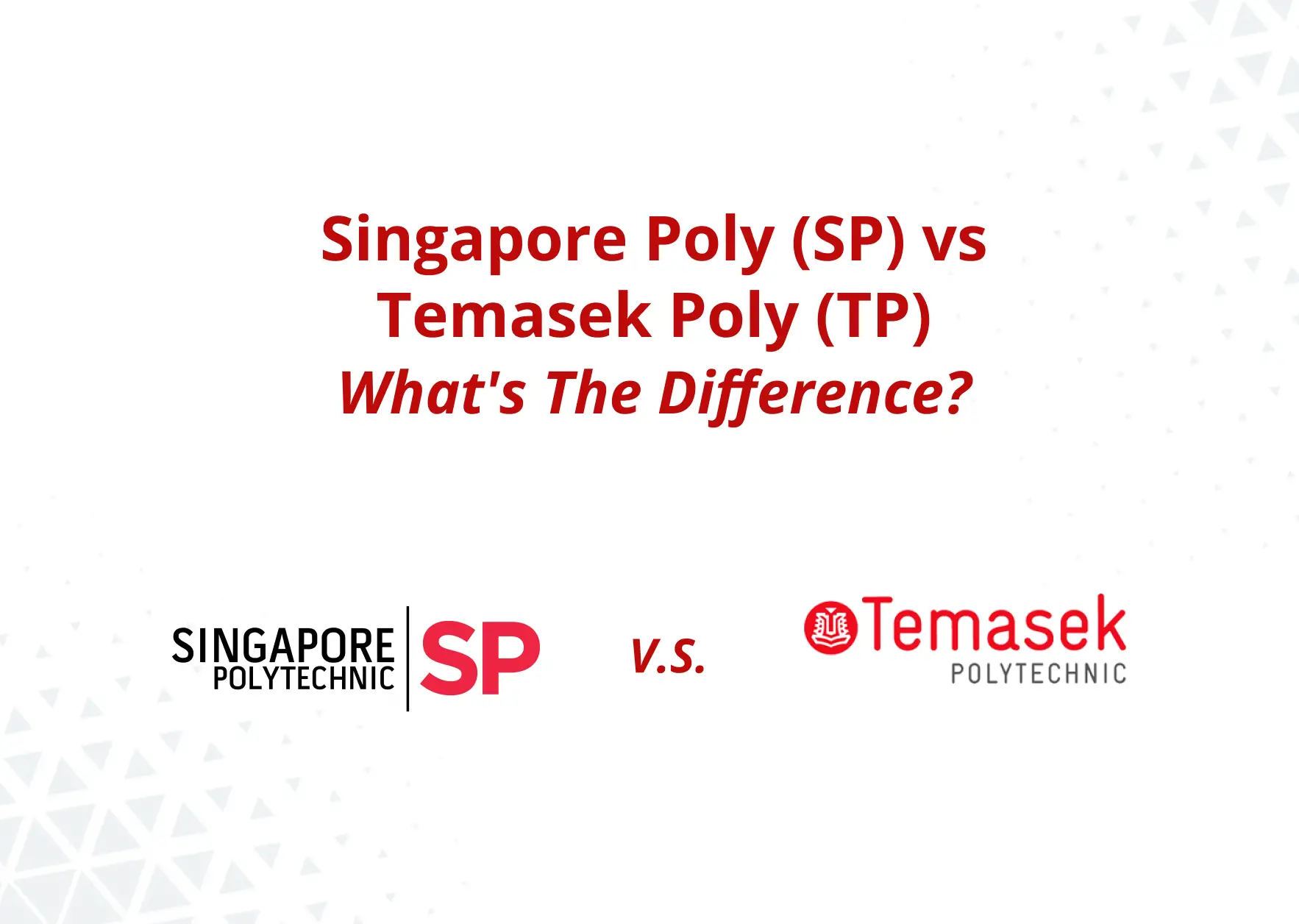Pursuing tertiary education, with the aim of university, will probably lead you on either of 2 paths – going to Junior College (JC) or Polytechnic. As mentioned in my previous article, going to University from Polytechnic is definitely possible, so that ultimately then begs the question – which Polytechnic do I choose?
But fret not, even if you’re not looking to go university but just polytechnic from ITE, this article is still for you too!
Well in today’s Clash of the Polytechnics, we have representing the Eastside – Temasek Polytechnic (TP) – and the Central – Singapore Polytechnic (SP).
“Fun fact, Singapore Polytechnic was actually the first polytechnic to be built, being established in 1954. Temasek Polytechnic, on the other hand, is the third polytechnic to be constructed, being established in 1990 – a whole 36 years later.”
But other than being built in completely different decades, these 2 polytechnics still have differences that set them apart so let’s take a closer look at them!
Contents
Location & Accessibility
TP is located at 21 Tampines Ave 1, Singapore 529757.
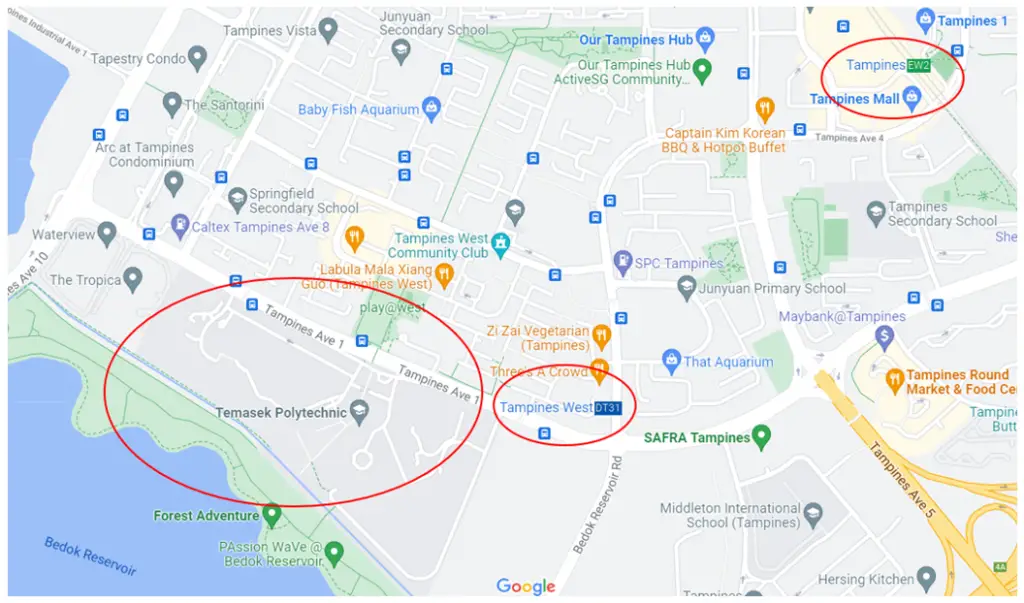
The nearest MRT station to TP is Tampines West of the Downtown Line, being only around 800m away from TP. This can translate into around an 8-10 minute walk depending on how fast your legs can go. But as you can see from the image above, Tampines West MRT station is in relatively close proximity to TP.
Alternatively, you can also choose to alight at either Tampines (circled above) or Bedok MRT station, which are part of the East-West Line (EWL), and then hop on a bus to take you to TP.
If you are alighting at Tampines MRT station, the buses you can take:
| Bus Number | Location |
|---|---|
| 8 | Tampines Bus Interchange |
| 23 | Tampines Bus Interchange |
| 69 | Tampines Bus Interchange |
| 129 | Tampines Concourse Bus Interchange |
If you are alighting at Bedok MRT station, the bus you can take:
| Bus Number | Location |
|---|---|
| 69 | Bedok Bus Interchange |
And finally, if you’re looking to get to TP by bus, these buses can alight you directly there.
| Bus Number | Location |
|---|---|
| 8 | Tampines Bus Interchange/Toa Payoh Bus Interchange |
| 15 | Pasir Ris Bus Interchange/Marine Parade Road |
| 23 | Tampines Bus Interchange/Rochor Station |
| 69 | Tampines Bus Interchange/Bedok Bus Interchange |
| 118 | Punggol Bus Interchange/Changi Business Park Terminal |
| 129 | Tampines Concourse Bus Interchange/St Michael’s Terminal |
| 518 | Pasir Ris Bus Interchange/Bayfront Ave |
Meanwhile, SP is located at 500 Dover Rd, Singapore 139651.
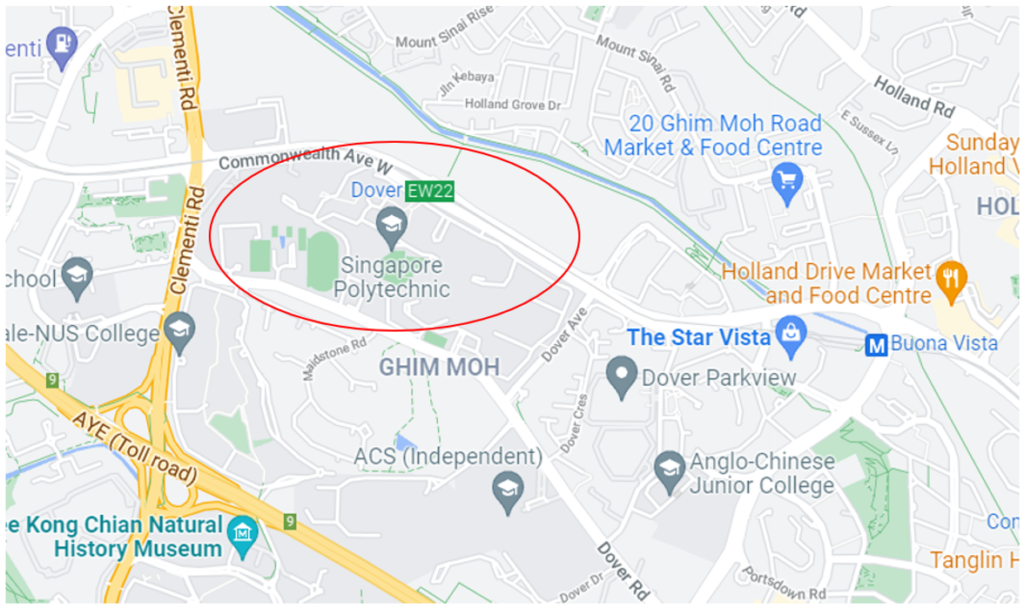
As seen pictured, the nearest MRT station to SP is Dover MRT station of the EWL. SP is by far the easiest polytechnic in Singapore to be accessed by MRT, being the only polytechnic to have an MRT station right at its doorstep.
However, if you do plan to take a bus instead, there is a large number of buses around Singapore that can drop you off directly at SP.
| Bus Number | Location |
|---|---|
| 14 | Clementi Bus Interchange/Bedok Bus Interchange |
| 33 | Kent Ridge Terminal/Bedok Bus Interchange |
| 74/74e | Hougang Central Bus Interchange/Buona Vista Terminal |
| 105 | Serangoon Bus Interchange/Jurong Bus Interchange |
| 106 | Bukit Batok Bus Interchange/Shenton Way Terminal |
| 147 | Hougang Central Bus Interchange/Clementi Bus Interchange |
| 166 | Ang Mo Kio Bus Interchange/Clementi Bus Interchange |
| 185 | Soon Lee Bus Park/Buona Vista Terminal |
| 196 | Bedok Bus Interchange/Clementi Interchange |
Closer Look at the 2 locations
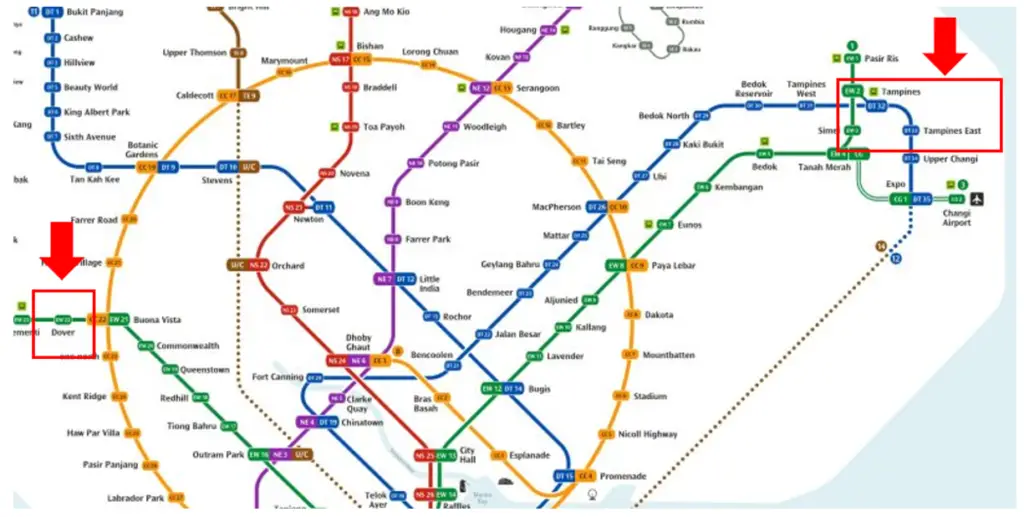
Taking a look at the locations of both schools on the MRT map, you can see that both schools are really far apart – being at the polar ends of the EWL.
Fortunately, both schools are readily accessible by MRT and buses so travelling to school won’t be too much of a pain for you. However, SP does have an advantage in this, with the MRT station (Dover) being located directly in front of SP.
Diplomas Offered and their Cut-off Points
Disclaimer: As the diploma content covered by each school does vary, the naming of each diploma might also vary
The following is a comparison of the different diplomas offered by each polytechnic (separated by their respective fields of study) and their ELR2B2 cutoff range.
Notes:
- Attached to each cutoff range is the link to the respective course page
- “-” indicates that the course is not offer
- “#” indicates that the cutoff is not available – possibly due to additional requirements
- Source: SP, TP
Applied Sciences
| Diploma | SP | TP |
|---|---|---|
| Chemical Engineering | 6-13 | 5-15 |
| Biomedical Science | 3-7 | – |
| Food Science | 5-12 | 7-14 |
| Biotechnology | – | 4-11 |
| Applied Chemistry | 3-9 | – |
| Perfumery & Cosmetic Science | 4-12 | – |
| Biomedical Engineering | – | 10-13 |
| Pharmaceutical Science | – | 5-11 |
| Veterinary Technology | – | 3-10 |
Built Environment
| Diploma | SP | TP |
|---|---|---|
| Architecture | 3-13 | 6-18 |
| Facilities Management | 12-18 | 11-19 |
| Civil Engineering | 5-22 | – |
| Integrated Events & Project Management | 7-15 | – |
| Landscape Architecture | 3-15 | – |
Business Management
| Diploma | SP | TP |
|---|---|---|
| Accountancy | 5-12 | 6-12 |
| Banking & Finance | 5-12 | – |
| Business Administration | 5-13 | – |
| Common Business Programme | 5-13 | 6-15 |
| Human Resource Management with Psychology | 5-12 | – |
| Business | – | 5-14 |
| Business Process & Systems Engineering | – | 12-17 |
| Communications & Media Management | – | 6-13 |
| Culinary & Catering Management | – | 8-18 |
| Hospitality & Tourism Management | – | 8-17 |
| Law & Management | – | 3-11 |
| International Trade & Logistics | – | # |
| Marketing | – | 6-15 |
Engineering
| Diploma | SP | TP |
|---|---|---|
| Aerospace Electronics | 5-15 | 6-26 |
| Aerospace Engineering | 5-15 | 5-18 |
| Common Engineering Programme | 5-16 | 10-24 |
| Computer Engineering | 4-13 | 9-14 |
| Electronics | 8-18 | 11-18 |
| Mechatronics | 4-15 | 13-18 |
| Engineering with Business | 6-12 | – |
| Mechanical Engineering | 6-19 | – |
Health Sciences
| Diploma | SP | TP |
|---|---|---|
| Optometry | 5-13 | – |
Humanities
| Diploma | SP | TP |
|---|---|---|
| Early Childhood Development & Education | – | 6-15 |
| Psychology Studies | – | 5-10 |
| Social Sciences in Gerontology | – | 10-14 |
Information & Digital Technologies
| Diploma | SP | TP |
|---|---|---|
| Applied Artificial Intelligence | 3-9 | 5-11 |
| Common ICT Programme | 5-12 | 4-16 |
| Infocomm Security Management | 3-11 | – |
| Information Technology | 3-14 | 6-16 |
| Big Data & Analytics | – | 5-13 |
| Cybersecurity & Digital Forensics | – | 6-13 |
| Game Design & Development | – | 6-13 |
Media & Design
| Diploma | SP | TP |
|---|---|---|
| Interior Design | 7-15 | 9-15 |
| Media, Arts & Design | 4-11 | – |
| Apparel Design & Merchandising | – | 5-12 |
| Communication Design | – | 6-16 |
| Digital Film & Television | – | 6-15 |
| Product & Industrial Design | – | 10-17 |
Maritime Studies
Both polytechnics offer you a wide range of courses to choose from with each of them also having courses unique to them.
“For example, SP offers Maritime Studies which TP doesn’t have and TP offers Veterinary Studies which SP doesn’t have.”
However, you can observe that, in general, for courses offered by both SP and TP, SP tends to have a slightly lower cutoff. For example, the cutoff range for TP for the Common Engineering Programme is 10-24 while the cutoff range is 5-16 for SP.
As such you might find it slightly harder to get into SP as compared to TP!
Admission Process
There are multiple ways to enter into each polytechnic depending on your academic qualifications (O-Level, N-Level, etc.). The admission process itself, however, does not vary much between the 2 polytechnics and are extremely similar.
The following sections will give you a brief idea of the possible paths that you can choose to take!
For O-Level Students and Graduates
If you have graduated with an O-Level certificate or are about to take your O-Levels this year, you can apply to either school through the Joint Admissions Exercise (JAE) or Early Admissions Exercise (EAE).
Joint Admissions Exercise (JAE)
The JAE is for students who have already completed their O-Levels and have just received their results. For both SP and TP, the JAE application begins on the day of the O-level result release and spans for 6 days.
“So in 2021, the application period began on the 12th of January, lasting till 17th January.”
You can apply to either polytechnic through the JAE-Internet System (JAE-IS), which will only be accessible during the appropriate application period as stated.
Early Admissions Exercise (EAE)
The EAE is for students who have yet to take their O-Levels but are registered to take it in the year of the EAE. So if the student is registered to take their O-Levels in 2022, they can choose to apply for the EAE in the same year.
So if you’re looking to apply to SP or TP through the EAE, based on 2021’s EAE, the application for both schools will take place in June. The period in June in which it takes place does not differ for both schools.

For both TP and SP, the EAE in 2021, took place from the 24th of June and lasted for a single week, up till the 30th of June.
“As at the point of your EAE application, you would not have yet taken your O-Levels, your admission will be assessed based on different criteria – such as an online write-up, secondary school exam results, portfolio reviews etc.”
And from there, if you are shortlisted, you can expect to go through interviews or aptitude tests for further selection. An in-depth idea of additional requirements or what you should know beforehand can be found in the links provided in the preceding paragraph!
You can apply to either polytechnic through the EAE website during the appropriate application period.
For N-Level Students
If you’re currently doing your N-level, you can choose to apply to TP or SP via their Polytechnic Foundation Programme (PFP), after you have taken your N-Level.
A brief explanation of what the PFP is is that it is an alternative to the Sec 5 year.
“So if your application is successful, instead of doing Sec 5, you will instead do an academic year in polytechnic – A.K.A Year ‘0’ as coined by my friends who underwent PFP.”
In this year ‘0’ you will be required to complete and pass a set of modules that are related to your diploma of interest, to progress into Year 1 of your polytechnic studies.
The application period for the PFP actually coincides with the application period for the JAE – also taking place on the day of the O-Level result release and lasting for 6 days. Your application for the PFP of either school is done online here.
“As the admission process for both polytechnics are almost identical, the requirements for the PFP for both schools also follow suit.”
For both polytechnics(TP, SP), you are required to obtain an N-Level score of 12 points or better for your ELMAB3 (English Language, Mathematics, Best 3 subjects). One of your best 3 subjects is also required to be relevant to your diploma of interest.
For ITE Students & Graduates
The application process, if you are from ITE, is very similar to the application process for O-Level students. You can apply to either polytechnic through the Joint Polytechnic Admissions Exercise (JPAE) – equivalent to the JAE – or similarly, through EAE.
Joint Polytechnic Admissions Exercise (JPAE)
Like the JAE, the JPAE is for ITE students who have completed their NITEC or Higher NITEC.
For both polytechnics (TP, SP), to be eligible for admission, you will have to meet the minimum GPA requirements for your course of interest. Your ITE certificate should also be relevant to the course you wish to attend. The GPA requirements can be found on the JPAE website here.
To find the GPA requirements in the link provided, first, select your applicant type then pick the qualification which you possess. (boxed in red below)
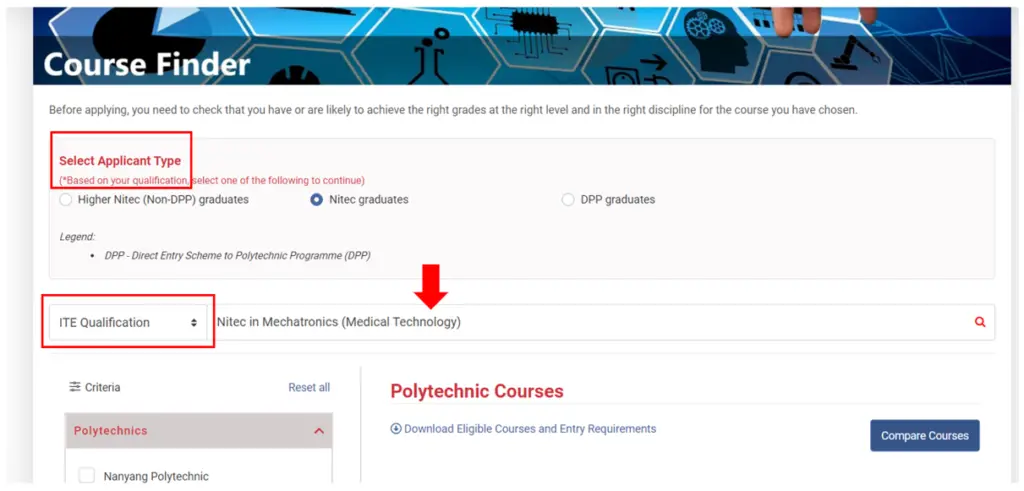
From there, select your polytechnic of choice and a list of courses should appear, together with their average GPA band – giving you a rough idea of the GPA range for the course.
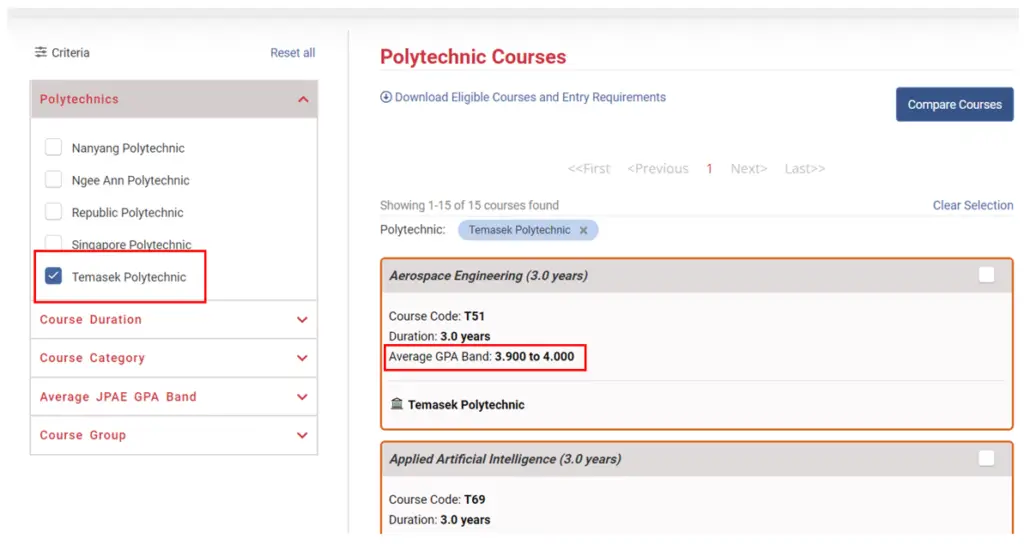
You can apply to either of the polytechnics through the JPAE website during the appropriate timeframe. For the JPAE in 2022, the application will be open from the 21st of February at 9 am to the 25th of February at 4 pm.
Early Admissions Exercise (EAE)
The EAE is open to graduating final-year Nitec and Higher Nitec students from ITE.
The list of courses available through the EAE for ITE students can be found here, alongside their requirements too. The EAE application period for ITE students takes place 2 weeks before the EAE application of O-Level applicants.

In 2021, applications began on the 10th of June and ended on the 16th of June – taking place 2 weeks before application by O-Level students.You can apply online via the EAE site for ITE students.
This site is different from the site used by O-Level students so be sure to select the correct one!
Summary
In conclusion, the admission process to either polytechnic does not have much difference so you need not worry too much about it!
Differences only arise depending on the academic qualifications that you possess.
Grading System
An in-depth look at each schools grading system can be found on their respective websites – TP, SP
You will be graded the same way in both polytechnics – following the Grade Point Average (GPA) system.
Under this system, any of your modules that are not assigned a grade point are not included in the calculation of your GPA and assigned either a pass or fail grade.


Modules that are assigned a grade point are then used to calculate your Semester GPA and your Cumulative GPA.

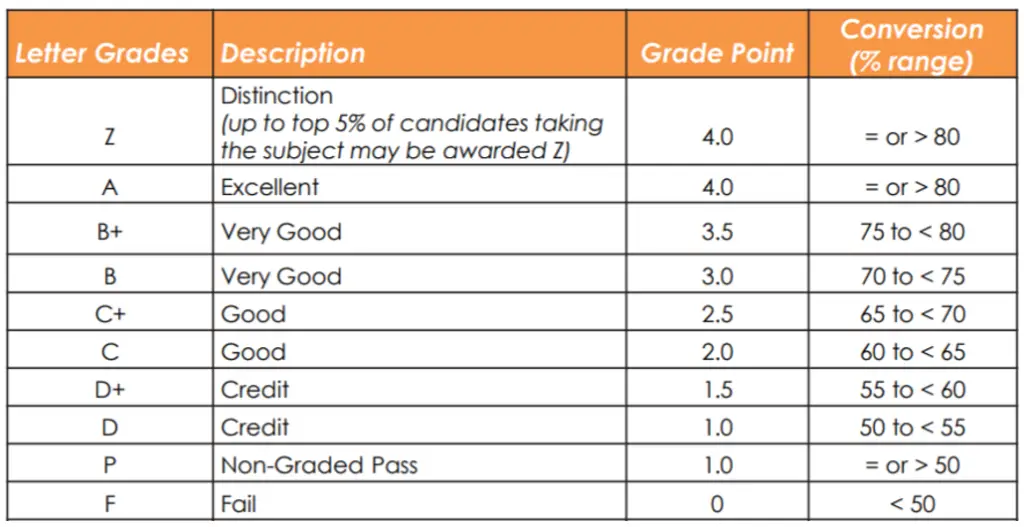
As seen from the snippets from both schools, based on your obtained grade, you will ‘score’ a specific grade point. This grade point will then be used to calculate the GPA.
“So for example, if you get an A or Distinction, you will ‘score’ the full grade point of 4 but if you get a B, you will only ‘score’ a grade point of 3.”
For both TP and SP, there are 2 kinds of GPA calculated, as mentioned above:
- Your Semester GPA
- Your Cumulative GPA
The difference between the two is that the Semester GPA is solely based on modules taken that semester. The Cumulative GPA however, is based on all modules taken up till and including that semester.
“Based on my time in polytechnic, there isn’t much significance in differentiating the two and they are just 2 different ways that your grades can be represented!”
The way that your GPA is calculated for both schools is also identical.


The subject grade point refers to the grade point obtained based on your module grade – for example; a ‘B’ grade corresponds to a grade point of 3.
The credit units assigned refer to the module credits assigned to a specific module – The number of credits assigned differs between modules.
An example of how GPA is calculated:
| Module Name | Module Grade | Module Credit | Grade Point | Module Credits x Grade Points |
|---|---|---|---|---|
| A | A | 3 | 4 | 12 |
| B | B | 2 | 3 | 6 |
| C | A | 4 | 4 | 16 |
The GPA obtained would be (12+6+16)/(3+2+4) = 3.78.
Breaking this down:
- (12+6+16) – refers to the sum of (Module Credits x Grade Points)
- (3+2+4) – refers to the total Module Credits for all 3 modules
CCAs offered
SP offers a wide and diverse range of CCAs which includes:
- Constituent Clubs – 12 CCAs
- Arts & Culture – 22 CCAs
- Special Interests – 21 CCAs
- Service Learning – 7 CCAs
- Sports and Adventure – 48 CCAs
There are around 110 CCAs for you to choose from at SP so you really are spoiled for choice. SP does also offer CCAs that are not offered by TP – such as Shooting or Krav Maga if you’re interested in those.
A full list of CCAs available can be found here.
Whether your interest lies within the Performing Arts, Sports or Astronomy, I do not doubt that you will be able to find something in SP that piques your interest.
TP offers a slightly smaller selection of CCAs
While SP boasts an impressive selection of over 100 CCAs, TP in contrast only offers around 80 CCAs for you to pick from.
However, this smaller selection does not mean that TP’s CCAs lack diversity as there is still a wide range for you to choose from. This includes:
- Performing Arts – 14 CCAs
- Sports – 33 CCAs
- P10 Clubs – 10 CCAs
- Interest Groups – 23 CCAs
A full list of CCAs available can be found here.
“As such, I would say that while TP does have a slightly smaller selection of CCAs to choose from, it is still equally diverse as compared to SP’s CCA choices.”
Furthermore, many of the staple CCA’s such as Dance, Choir, Sports (Basketball, Swimming, Hockey, etc.) are still offered in both polytechnics.
The ones that are unique to SP such as shooting are more niche activities and may not suit your interests. As such having a slightly bigger selection to choose from, may not necessarily matter to you – unless you do want to try out something new!
Personally for me when I was in polytechnic, my only interest was in Dance so I had my mind set on joining a dance CCA. As such, even if there were a thousand CCAs to choose from, it wouldn’t have mattered to me!
Facilities
Here is a side-by-side comparison of some commonly used facilities offered that you might be interested in:
| TP | SP | |
|---|---|---|
| Swimming Complex | ✓ | ✓ |
| Badminton Courts | ✓ | ✓ |
| Running Track | ✓ | ✓ |
| Basketball Courts | ✓ | ✓ |
| Gym | ✓ | ✓ |
| Tennis Courts | ✓ | ✓ |
| Squash Courts | ✓ | ✓ |
| Library | ✓ | ✓ |
| Retail/Bookstores | ✓ | ✓ |
| ATM | ✓ | ✓ |
| Photocopy Services | ✓ | ✓ |
In general, I would say that both TP and SP offer the same types of commonly used facilities as most of the polytechnics in Singapore are equipped quite similarly. While the stores themselves might differ, their general purpose does still stay the same.
For example, 1st Avenue of TP vs Popular Bookstore of SP – while both are not the same stores, they both still serve a similar purpose of providing students with a place where they can stock up on stationeries or other school essentials.
“There are some other small differences as no two schools are the same. Such as with dining options, where SP has KFC, Starbucks and Subway while TP only has McDonald’s and Subway.”
However, I would say that such differences might not be as significant as ultimately, the facilities still serve the same purposes.
Other Factors To Be Considered
Other than the differences mentioned above, there are also other factors that you might want to consider when choosing between the two.
“Reviews” of the Polytechnic
Finding the different reviews of TP or SP or the diploma that you are interested in is not very hard in this digital age. On sites such as Reddit, you can easily access the respective polytechnic pages (SP, TP) or pages like the popular SGExams, and look up questions that you might have.
And more than likely, someone would have had the same question in mind before and gotten a response to their question.
Looking up how students of the respective polytechnics feel about their time there, can give you a brief idea of what to expect and if you think that school would be suitable for you!
The Environment of the School
While online searches of the facilities available or the map of TP and SP can give you a rough idea of what the schools offer, it just can’t give you a sense of the school’s environment.
In simpler terms, you have to give the school a “vibe check”. As weird as it might sound, how you feel when you’re in school is an important factor when considering between the two schools in my eyes.
“For example, I didn’t like how I felt in SP as everything just felt too open and wide for me, considering the school’s size, and was one of the reasons why I eventually decided to settle for Nanyang Polytechnic.”
However, this definitely isn’t the same for everyone. As quoted from this Youtuber, “I remember stepping into SP and had that instantaneous vibe that I could study here”.
As such, the different vibes that SP or TP can give off to you is different from everyone’s and is something that you just have to experience for yourself!
Final Verdict
Concluding, both TP and SP do offer a wide range of diplomas that you can choose from, with each offering their own unique specialisations – such as the Nautical Studies of SP. Unfortunately, it might be a tad bit harder for you to get into SP as their cutoff range is slightly lower as compared to TP’s in most cases.
However, I would say that both schools are slightly on par with each other in terms of the types of diplomas offered to you and the facilities available.
Location wise, both are also fairly accessible by MRT or bus, even though SP does have the edge of having Dover MRT right as its doorstep. But in the end, it does still come down to where you stay and how far you are willing to travel to and fro from school daily.
However, in my eyes, other than these more obvious differences (location, diplomas or CCAs offered), looking up more subtle differences such as the school’s environment or the diploma experiences of current/ex-students are also valid considerations that you can take in.
With that, I hope that this article has helped shed some light on the differences between SP and TP while also introducing other considerations that you might want to look at between the 2. I wish you the best of luck with choosing the right polytechnic!
If you enjoyed this content, do follow us on Telegram!

Want to earn some money while sharing your experiences in Singapore? We’re always looking for writers and you can join our team here!
